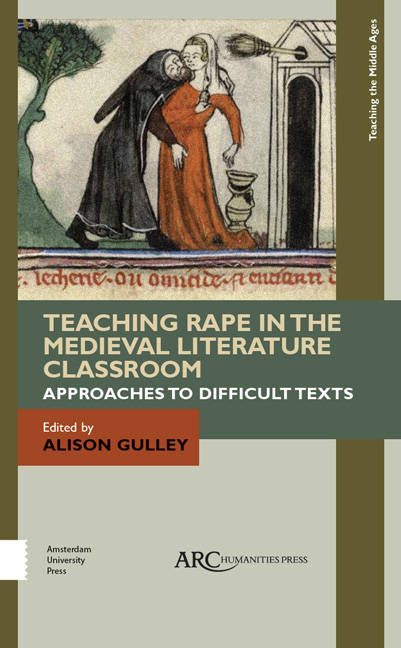Book contents
- Frontmatter
- Contents
- Acknowledgements
- Chapter 1 Introduction: Teaching Rape and Meeting the Challenges of the TwentyFirstCentury Classroom
- Chapter 2 Medieval Saints and Misogynist Times: Transhistorical Perspectives on Sexual Violence in the Undergraduate Classroom
- Chapter 3 Teaching Medieval Rape Culture across Genre: Insights from Victimology
- Chapter 4 Bringing the Bystander into the Humanities Classroom: Reading Ancient, Patristic, and Medieval Texts on the Continuum of Violence
- Chapter 5 From Bystander to Upstander: Reading the Nibelungenlied to Resist Rape Culture
- Chapter 6 Speech, Silence, and Teaching Chaucer’s Rapes
- Chapter 7 Classroom PSA: Values, Law, and Ethics in “The Reeve’s Tale”
- Chapter 8 “How do we know he really raped her?”: Using the BBC Canterbury Tales to Confront Student Skepticism towards the Wife of Bath
- Chapter 9 Teaching the Potiphar’s Wife Motif in Marie de France’s Lanval
- Chapter 10 Sexual Compulsion and Sexual Violence in the Lais of Marie de France
- Chapter 11 Troubadour Lyric, Fin’amors, and Rape Culture
- Chapter 12 The Knight Coerced: Two Cases of Raped Men in Chivalric Romance
- Chapter 13 Teaching Rape to the HeMan Woman Haters Club: Chrétien de Troyes at a Military School
- Chapter 14 Rape, Identity, and Redemption: Teaching “Sir Gowther” in the Community College Classroom
- Notes on Contributors
- Index
Chapter 6 - Speech, Silence, and Teaching Chaucer’s Rapes
Published online by Cambridge University Press: 23 January 2021
- Frontmatter
- Contents
- Acknowledgements
- Chapter 1 Introduction: Teaching Rape and Meeting the Challenges of the TwentyFirstCentury Classroom
- Chapter 2 Medieval Saints and Misogynist Times: Transhistorical Perspectives on Sexual Violence in the Undergraduate Classroom
- Chapter 3 Teaching Medieval Rape Culture across Genre: Insights from Victimology
- Chapter 4 Bringing the Bystander into the Humanities Classroom: Reading Ancient, Patristic, and Medieval Texts on the Continuum of Violence
- Chapter 5 From Bystander to Upstander: Reading the Nibelungenlied to Resist Rape Culture
- Chapter 6 Speech, Silence, and Teaching Chaucer’s Rapes
- Chapter 7 Classroom PSA: Values, Law, and Ethics in “The Reeve’s Tale”
- Chapter 8 “How do we know he really raped her?”: Using the BBC Canterbury Tales to Confront Student Skepticism towards the Wife of Bath
- Chapter 9 Teaching the Potiphar’s Wife Motif in Marie de France’s Lanval
- Chapter 10 Sexual Compulsion and Sexual Violence in the Lais of Marie de France
- Chapter 11 Troubadour Lyric, Fin’amors, and Rape Culture
- Chapter 12 The Knight Coerced: Two Cases of Raped Men in Chivalric Romance
- Chapter 13 Teaching Rape to the HeMan Woman Haters Club: Chrétien de Troyes at a Military School
- Chapter 14 Rape, Identity, and Redemption: Teaching “Sir Gowther” in the Community College Classroom
- Notes on Contributors
- Index
Summary
At every turn, rape is an interpretive act.
Rachel Warburton, “Reading Rape in Chaucer”He said/ she said: the invariable shorthand for the challenges of deciphering occluded events of violence and violation, in which the question of which story we believe— that of the accused or of the accuser— bears out innumerable consequences related to our conceptions of justice, gender, and sexuality, both in the past and continuing into the present. Chaucer depicts rape and scenes suggestive of rape in several of his Canterbury Tales, most notably “The Miller's Tale,” “The Reeve's Tale,” and “The Wife of Bath's Tale,” and in his Legend of Good Women as well, particularly in the Legend of Lucrece and the Legend of Philomela, with these encounters highlighting the ways in which speech and silence formulate readers’ reactions to sexual violence. Various medieval theologians and exegetes extol silence as a woman's defining virtue, yet Chaucer's narratives both reinforce this prevailing view and allow readers to consider how male speech either excuses or condemns violent enactments of male sexuality.
By foregrounding in our classrooms the ways in which Chaucer depicts speech and silence as gendered reactions to sexual violence, instructors can illuminate the various ways that literary depictions of rape simultaneously reinforce and undermine medieval constructions of gender. Such a perspective also allows scholars and students to consider the ways in which we choose— or choose not— to speak of Chaucer's vexing identity as a potential rapist in his interactions with Cecily Champaigne— a biographical event in which textuality, speech, and silence converge to haunt our understanding of Chaucer's benevolently paternal image as the “Father of English Literature.” In the pages that follow I discuss converging teaching strategies for addressing Chaucer's depictions of rape that I employ in my classes at the University of Central Florida— a large, metropolitan, public institution with students from a diverse range of backgrounds, with varying previous exposure to medieval literature, to gender theory, and to literary theory.
Speech and silence play constitutive roles in both gender theory and literary theory, and clarifying this confluence for students opens new avenues for their mutual exploration in various texts.
- Type
- Chapter
- Information
- Teaching Rape in the Medieval Literature ClassroomApproaches to Difficult Texts, pp. 77 - 90Publisher: Amsterdam University PressPrint publication year: 2018



